The 7 Functions of Marketing (With Examples)

Sorry, there were no results found for “”
Sorry, there were no results found for “”
Sorry, there were no results found for “”

When you walk into your favorite coffee shop and already know what you’re ordering, that’s marketing quietly doing its job.
It’s the reason the brand feels familiar, the vibe feels right, and you somehow ended up following them on Instagram without even thinking about it.
But marketing is so much bigger than a clever ad or a great logo.
It’s everything that gets your audience not just aware of what you sell, but genuinely excited about it.
Because marketing touches so many parts of a business, the discipline is broken down into seven core functions—each one essential in shaping how a brand shows up in the world.
Whether you’re a marketer sharpening your strategy or a founder trying to grow with limited resources, these seven pillars are the backbone you build on.
In this post, we’ll break down all seven marketing functions, show real examples, cover the best channels to activate them, and share how to run it all more effectively.
The seven marketing functions are the building blocks that help your business connect the right products with the right people and keep them coming back.
Here are the seven stages for marketing campaign management 👇
With ClickUp for Marketing Teams, you have access to pre-built templates, dashboards, automation, a built-in AI assistant, and forms. Together, they help you centralize all your other marketing functions in addition to the following.
At the promotion stage of product and service management, you convey the right message at the right time across various channels with a successful marketing strategy.
Brands use promotional marketing campaigns to spark interest around a new launch. They also use it to keep the buzz going after the launch.
🌸 Quick case study: Nike’s “So Win” Super Bowl LIX ad generated massive buzz, earning the Super Clio Award and reaching millions during the game’s broadcast.
The campaign featured 60 seconds of black-and-white footage with female athletes, helping Nike capitalize on the 20% year-over-year growth in women’s sports viewership.
Here are some channels you can use in your promotion strategy.
📌 Example: You’re launching a new AI-powered automation feature in your SaaS productivity platform. Here’s how you roll it out:
You can either keep all this data in spreadsheets or centralized within ClickUp for Project Management.
ClickUp gives your marketing teams a scalable system for collaboration, visibility, execution, and tracking. Let’s see how.
Think of ClickUp Tasks as a task management platform that you use to manage every moving piece of your marketing campaign.
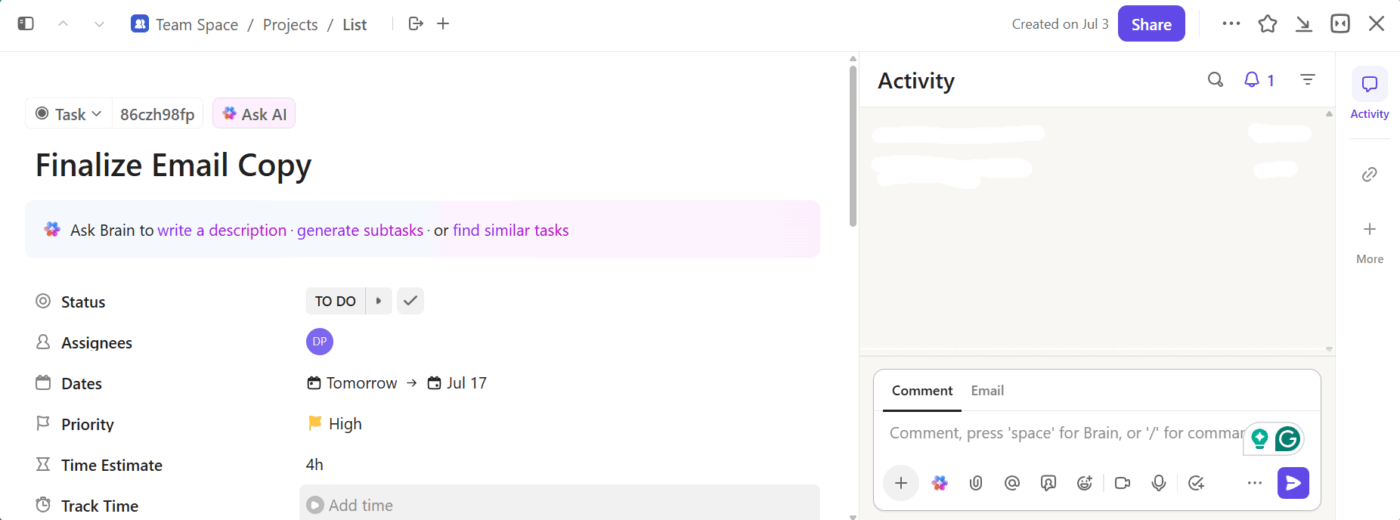
When you run the multi-channel promotion, each task, like ‘Launch Instagram ads’ or ‘Finalize email copy,’ can be broken down with clear descriptions, owners, deadlines, and subtasks. You can even track time spent, attach key assets, and add priority labels so your marketing team always knows what’s urgent.
When you need to see the bigger picture, milestones, and what the next tasks are for the progress of the project, you can use ClickUp Views. They allow you to visualize your tasks in List, Board, Calendar, or Gantt formats.

✅ Try This: Use tools like Google Analytics, Meta Audience Insights, or Instagram polls to understand your target audience, where they hang out, and what they care about. You can then plan your promotion mix like a campaign. Mix high-reach channels (like paid ads) with high-trust ones (like email, news coverage, or influencer shoutouts) to build credibility.
Want to learn how to create a marketing playbook from the ground up? Watch this tutorial:
At the selling stage, your marketer’s job is to guide the prospective customer from “this looks interesting” to “I need this.” One of the seven marketing functions, selling involves understanding customer demographics, communicating value, and building trust along the way.
🌸 Quick case study: Sephora’s facial recognition app led to a 25% increase in purchases and a 15% boost in in-store conversions. By letting users virtually try on products, Sephora bridged the gap between digital and physical retail, driving a measurable lift in sales.
The widely used selling strategies are:
📌 Example: Your SaaS startup offering productivity software uses ClickUp Forms to collect leads from a free webinar and collate them in a centralized workspace using ClickUp CRM (more on this later). The sales team members review the form responses and encourage two-way communication in their selling process to educate potential customers.
With ClickUp Automations and AI Agents, you can automate how the leads are qualified.
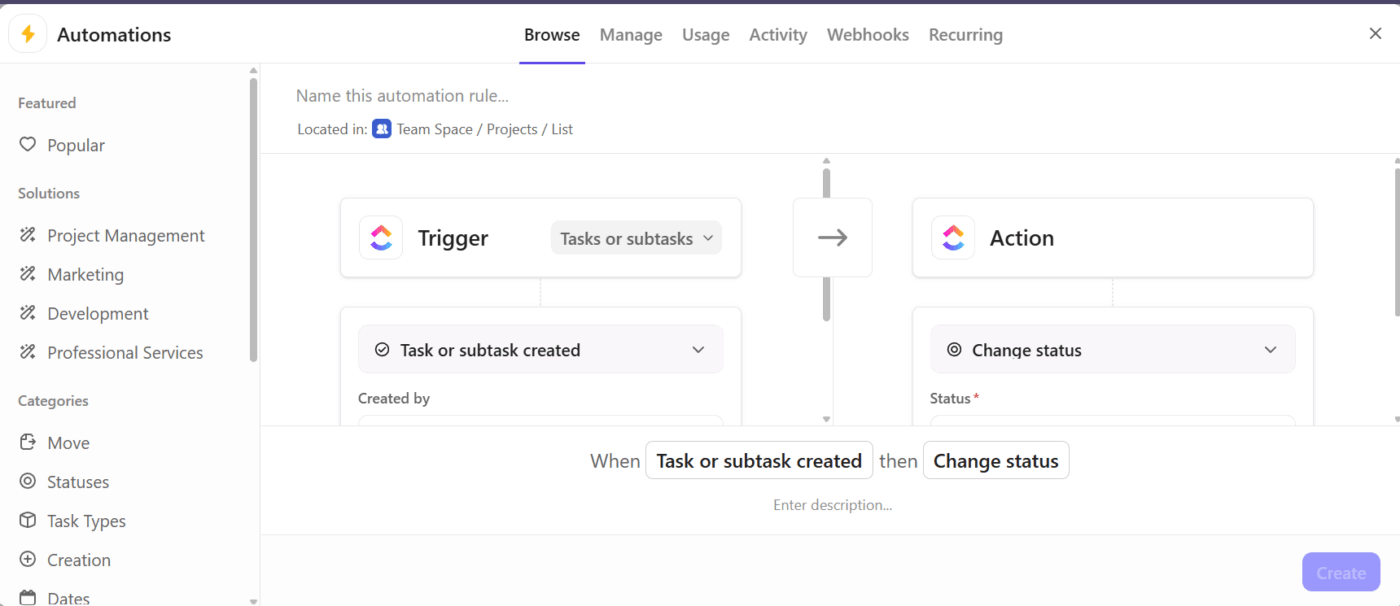
For instance, once a lead fills out a form, you can automatically create a task, assign it to a specific sales rep, and set a due date based on priority.
After a demo call is marked as complete, you can trigger an automated task to send a follow-up email and attach a relevant case study.
You can build automations to change task statuses when deals move down the funnel (like from ‘Lead Qualified’ to ‘Demo Scheduled’), or alert your team via email when a hot lead needs attention.
If your marketing team is still on the fence, this video will help you understand the benefits of ClickUp Automations.
⚡ Template Archive: Free Marketing Campaign Templates to Simplify Campaign Planning and Exection
Product or service development is all about ensuring what you’re selling actually meets your audience’s needs, today and tomorrow. This function extends beyond the launch, focusing on gathering feedback, improving existing offerings, and sometimes creating something entirely new. If you’re not evolving, your competitors will.
🌸 Quick case study: Dove’s “Real Beauty AI” campaign reached over 50 million users in its first month, using AI to show the impact of beauty filters. The campaign sparked a 40% increase in social media mentions of Dove and reinforced its reputation for authenticity.
Here are some product and service management strategies worth using:
📌 Example: Let’s say you’re creating a product or marketing roadmap for your productivity platform. Here’s how ClickUp Brain, ClickUp’s built-in AI assistant, can help you move faster from strategy to execution.
Turn ideas into roadmap tasks
Ask Brain to ‘Create a Q3 content roadmap for SEO, influencer marketing, and email campaigns for my SaaS product.’ You will get tasks or subtasks, complete with deadlines, owners, and priorities.
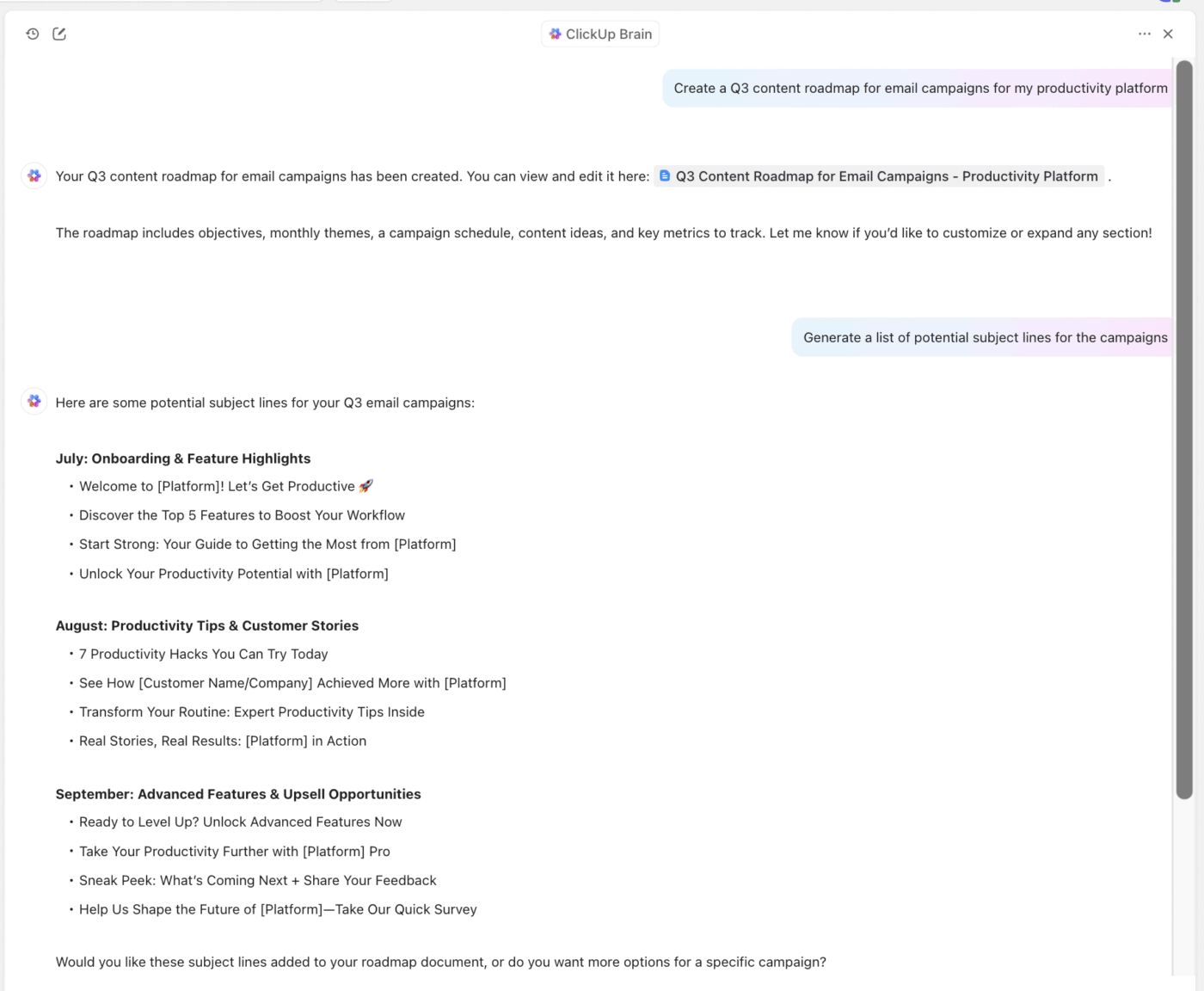
Ask questions about existing plans
Not sure what’s already planned? Ask Brain:
What features are scheduled for September?
What are the Product Hunt activities planned for the product launch?
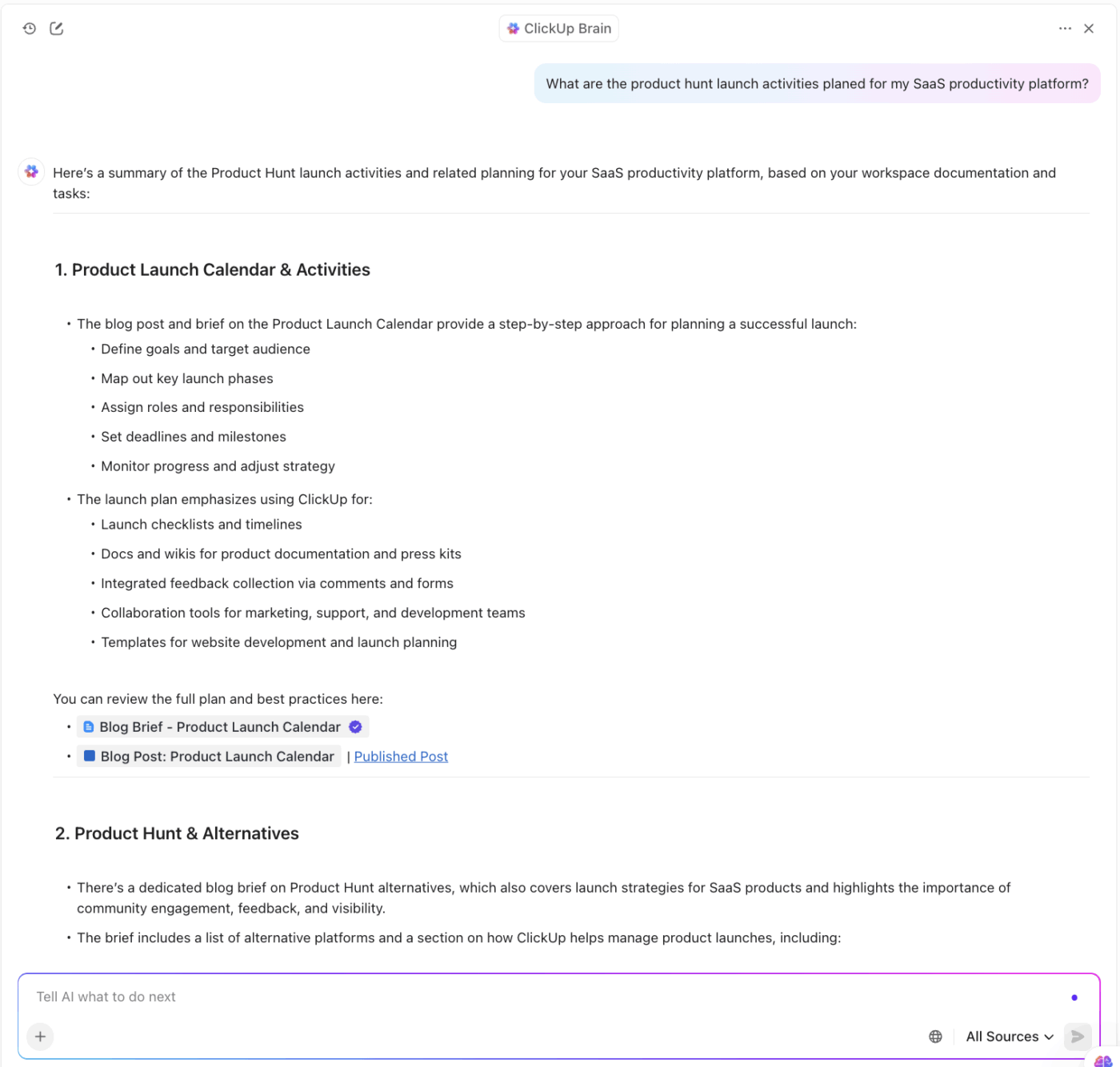
Summarize product or campaign plans
When you’re working on complex roadmap docs, you can ask Brain to summarize critical information. This is useful for exec updates, stakeholder syncs, or internal newsletters.

Brain MAX is your AI-powered desktop companion that transforms marketing by combining deep integration, automation, and the power of multiple leading AI models. With Brain MAX, you can save up to 1.1 days per week and achieve up to 86% cost savings by streamlining campaign planning, content creation, and analytics—all in one place.
Use talk-to-text to quickly brainstorm ideas, draft posts, or outline strategies, and let Brain MAX’s suite of AI models (like GPT, Claude, and Gemini) generate creative copy, analyze campaign data, and surface actionable insights. It can automatically track performance metrics, identify trends, and recommend optimizations, so you can target the right audience and maximize ROI. From automating social scheduling to organizing team feedback, Brain MAX keeps your marketing workflow efficient, data-driven, and always ahead of the curve.
📚 Read More: How to Use AI for Marketing?
MIM is a key function of marketing because it ensures marketers use timely, relevant, and accurate information to develop products, stay competitive in the market, and monitor campaign performance.
🌸 Quick case study: In 2024, Tombras made headlines with its weather-tailored “Impossibly Smart Billboard” campaign for PODS, deploying over 6,000 AI-powered, hyperlocal ads on trucks across New York City that adapted in real time to weather, location, and traffic. This innovative approach drove a 60% surge in website sessions and a 33% increase in quote requests for PODS in NYC, marking the company’s strongest weekly year-over-year growth in years.
Here’s what you can use for MIM:
📌 Example: You’re marketing a SaaS productivity platform and want to improve your email campaigns for freemium users.
Within ClickUp’s CRM Project Management Software you can assign follow-ups, track deal stages, and collaborate with your team for effective marketing management.
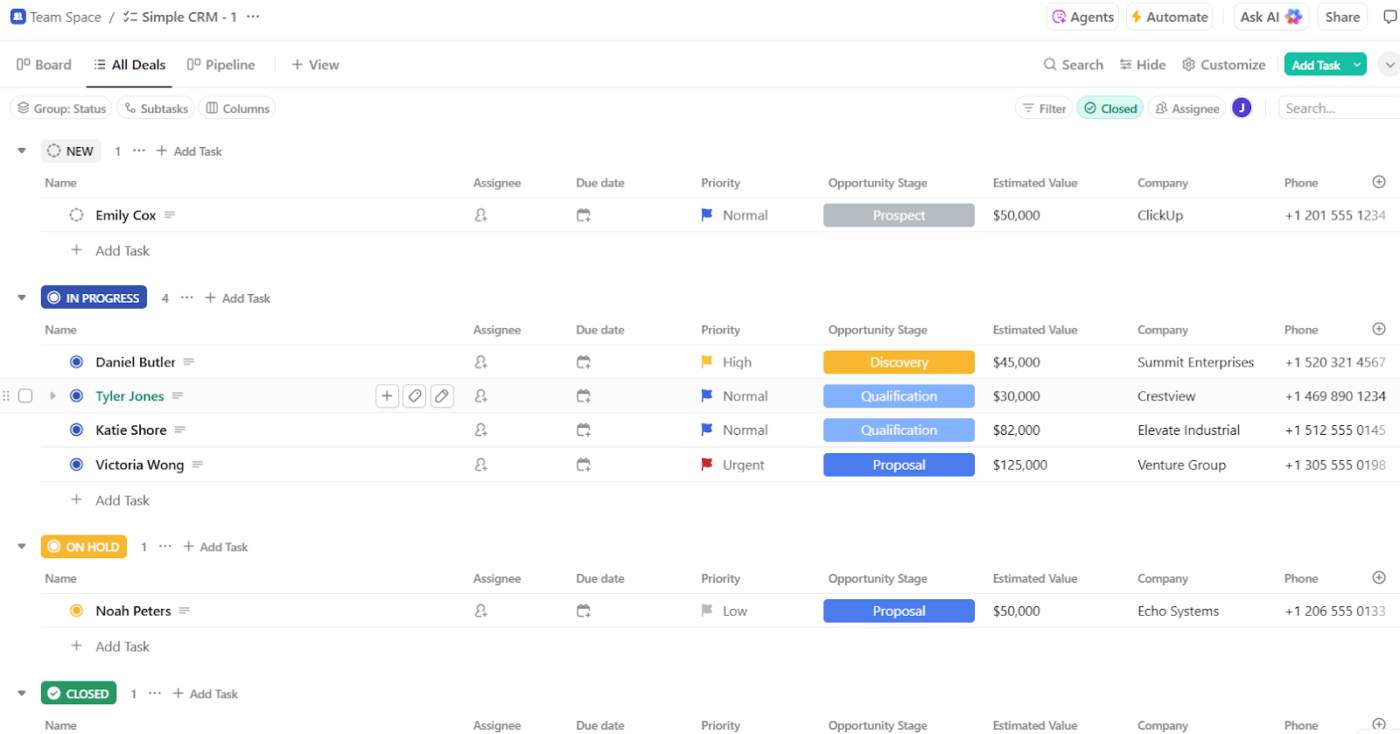
Firstly, to help your team sort and filter contracts based on persona, behavior, or funnel stage, use ClickUp List View. You can add custom fields such as lead source, last engagement data, customer segment, purchase stage, etc.
Additionally, you can even build a customer base to store and analyze contracts, customers, and deals. To track related work, consider adding links between your tasks and documents. No to-and-fro between different tools. With this CRM, you get all 7 functions of marketing in one tool.
📚 Read More: Marketing Operations Software For Teams
The pricing stage is where you decide what your product or service should cost (obviously), and why it’s worth it.
It’s a balancing act: covering your costs, staying competitive, and reflecting the value customers perceive. Get it right, and your pricing strategy supports both market growth and healthy profit margins.
🌸 Quick case study: Chili’s guerrilla pop-up in Manhattan drew crowds of over 10,000 people in a single weekend and generated 6 billion media impressions.
The campaign highlighted fast-food price hikes and promoted Chili’s new Big QP burger, resulting in a 12% sales spike for the launch week.
Here are some product pricing strategies you can use:
📌 Example: At ClickUp, we use a freemium + value-based tiered pricing model. Each tier is aligned with the scale, complexity, and needs of different users. It also supports land-and-expand growth: start small, grow usage, and upgrade as your team and workflow complexity increase.
Free trials are broken. And most SaaS founders refuse to admit it. If your product needs a countdown timer to force a decision, you’re solving the wrong problem. Here’s what actually happens with free trials:
Day 1-3: User signs up, explores a little, gets distracted.
Day 4-10: Radio silence. Maybe they log in once.
Day 11-13: Panic email. “Your trial expires soon!”
Day 14: Decision time. Except they never really used it.
This is the forced march to a decision nobody’s ready to make. We built ClickUp as Free Forever from day one. People thought we were insane.
“You’ll never monetize.”
“Users will just stay on free forever.”
“You need urgency to convert.”
Wrong. Free Forever removes the artificial pressure that makes users rush through your product. They take their time to build real workflows and experience genuine value.
Then when they hit the limits of free they upgrade because they want to, not because a timer forced them. Our free-to-paid conversion is better than the industry standard, and our customers stick around longer because they chose to pay after experiencing real value.
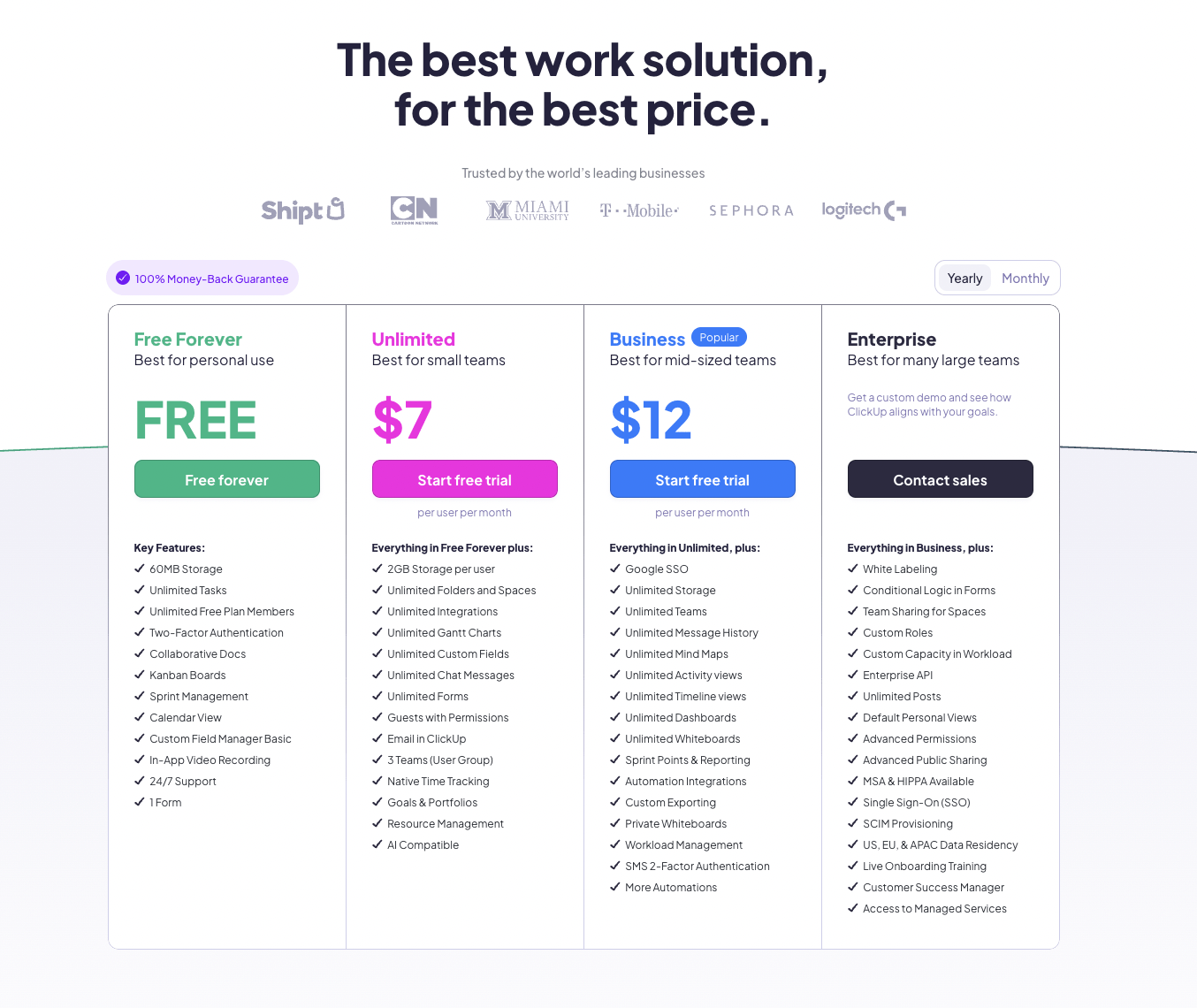
👀 Did You Know? Usage based pricing is taking on seat-based pricing in SaaS. As per an OpenView survey, 39% of companies charged based on usage. This is because it allows customers to start small and trial a product, and as customers get hooked to the product, it leads to seamless expansion.
In marketing, finance plays a core strategic role, guiding how resources are allocated, campaigns are prioritized, and ROI is measured.
Take experimentation in product management, for instance. Every growth team wants to test new channels or creative strategies. But without guardrails, A/B tests can quickly spiral into expensive guesswork.
The finance department defines safe, pre-approved spend limits—so teams can explore freely, without risking overspend on marketing plans.
Here’s how finance supports marketing:
Here, for everyone to be on the same page, the marketing team and the financing marketing department, you need a single source of truth.
📌 Example: You’re planning a Q4 growth sprint for your SaaS platform and need to allocate $75K across paid search, thought leadership content, and product-led webinars. You will use the marketing budget templates to plan finance and marketing KPIs.
📮ClickUp Insight: We recently discovered that about 33% of knowledge workers message 1 to 3 people daily to get the context they need. But what if you had all the information documented and readily available?
With ClickUp Brain’s AI Knowledge Manager by your side, context switching becomes a thing of the past. Simply ask the question right from your workspace, and ClickUp Brain will pull up the information from your workspace and/or connected third-party apps!
The distribution stage is where you get your product or message to the audience, through the right channels, at the right time. That could mean delivering digital content, managing partnerships, scaling influencer reach, or coordinating retail logistics.
🌸 Quick case study: The 2023 Barbie movie marketing campaign set a new standard for blockbuster promotion, driving over $1.4 billion in global box office revenue and becoming the highest-grossing film ever directed by a woman.
Powered by more than 100 brand partnerships, viral digital tools like the Barbie Selfie Generator (which boosted Mattel’s global reach by 279%), and experiential events such as the Barbie Dreamhouse Challenge, the campaign generated 179 million organic impressions and 4.6 billion hashtag views. Its appeal was especially strong among Gen Z, with 93% finding the marketing engaging and 81% of opening weekend viewers under 35, all while sparking the global “Barbiecore” trend.
When creating the distribution strategy, you take into account the channels driving the most conversations. You also answer a critical question, is our go-to-market motion aligned across sales, marketing, and operations?
Here are the core components of this stage:
📌 Example: You’re rolling out a new feature—AI-powered automation—to users in three phases: early adopters, power users, and the general base.
You use ClickUp Dashboards to track how this rollout is performing across marketing emails, in-app announcements, and community engagement. Real-time dashboards convert distribution from a black box into a controlled, data-driven workflow.

ClickUp connects marketing, sales, ops, and logistics in one workspace. Dashboards give everyone, from the marketing manager to the sales manager, a shared source of truth on how distribution is progressing.
👀 Did You Know? Several peer-reviewed studies show that channel context influences consumer perception of value and trust.
For example, a luxury item sold on a discount-heavy platform like Amazon may suffer perceived quality loss, even if it’s authentic.
The tools may have changed—TikTok instead of TV, AI instead of interns.
However, the fundamentals of marketing haven’t. The seven functions of marketing remain relevant because they represent the core responsibilities required to connect a product with the right audience in a meaningful, profitable way.
Each function answers a critical business question.
| Function | Core question |
| Promotion | How are we getting attention and driving action? |
| Selling | Are we converting interest into revenue? |
| Product or service management | Are we building something people actually want? |
| Marketing information management | What insights are guiding our decisions? |
| Pricing | Are we capturing value without killing demand? |
| Financing | Can we prove the ROI? |
| Distribution | Can people access our product when and where they need it? |
Now that you’ve got a clear view of the 7 marketing functions, it’s time to turn strategy into action.
And that’s where ClickUp comes in. If you’re mapping out your product roadmap, tracking leads, analyzing campaign data, or coordinating your next launch across channels, ClickUp gives your team one place to plan, organize, and execute every part of the marketing process.
From automations and ClickUp Brain to CRM and custom dashboards, you’ve got everything you need to market smarter.
Sign up on ClickUp for free today! ✅
© 2025 ClickUp